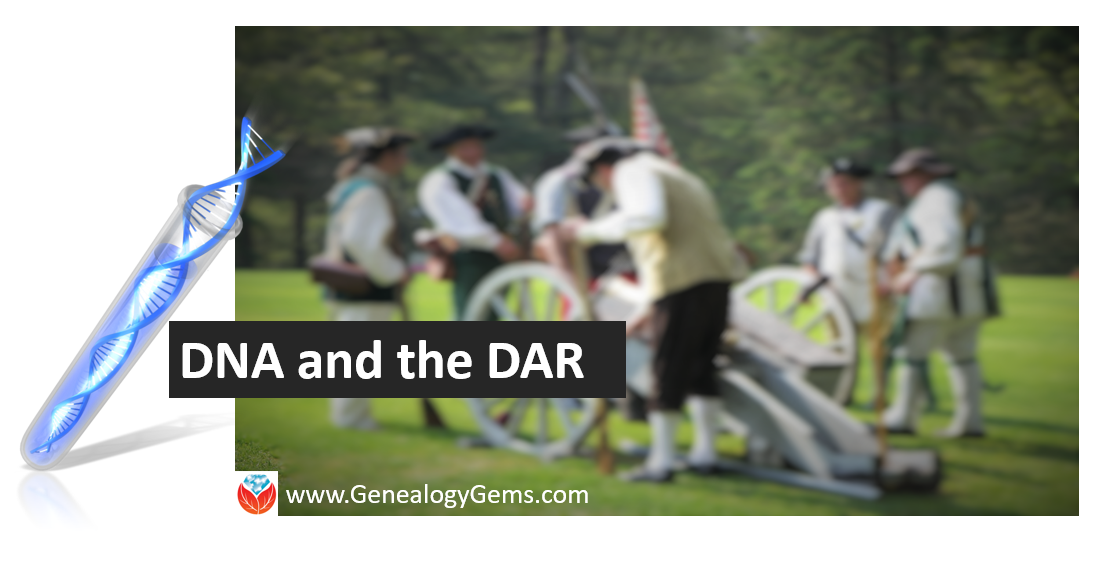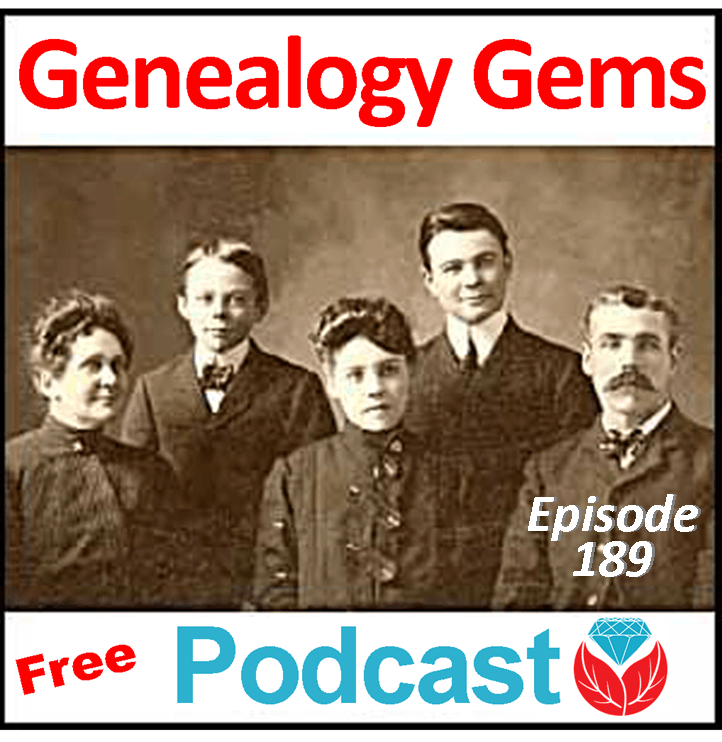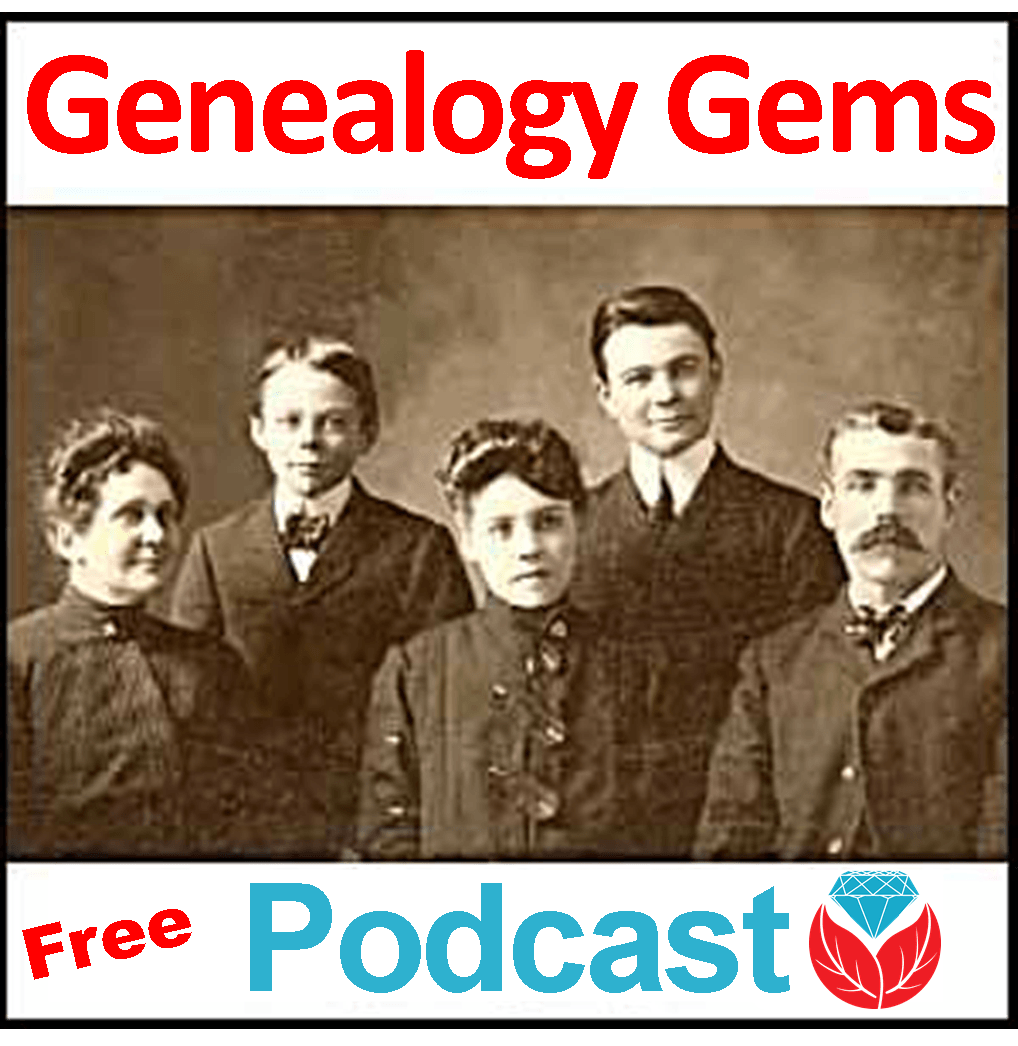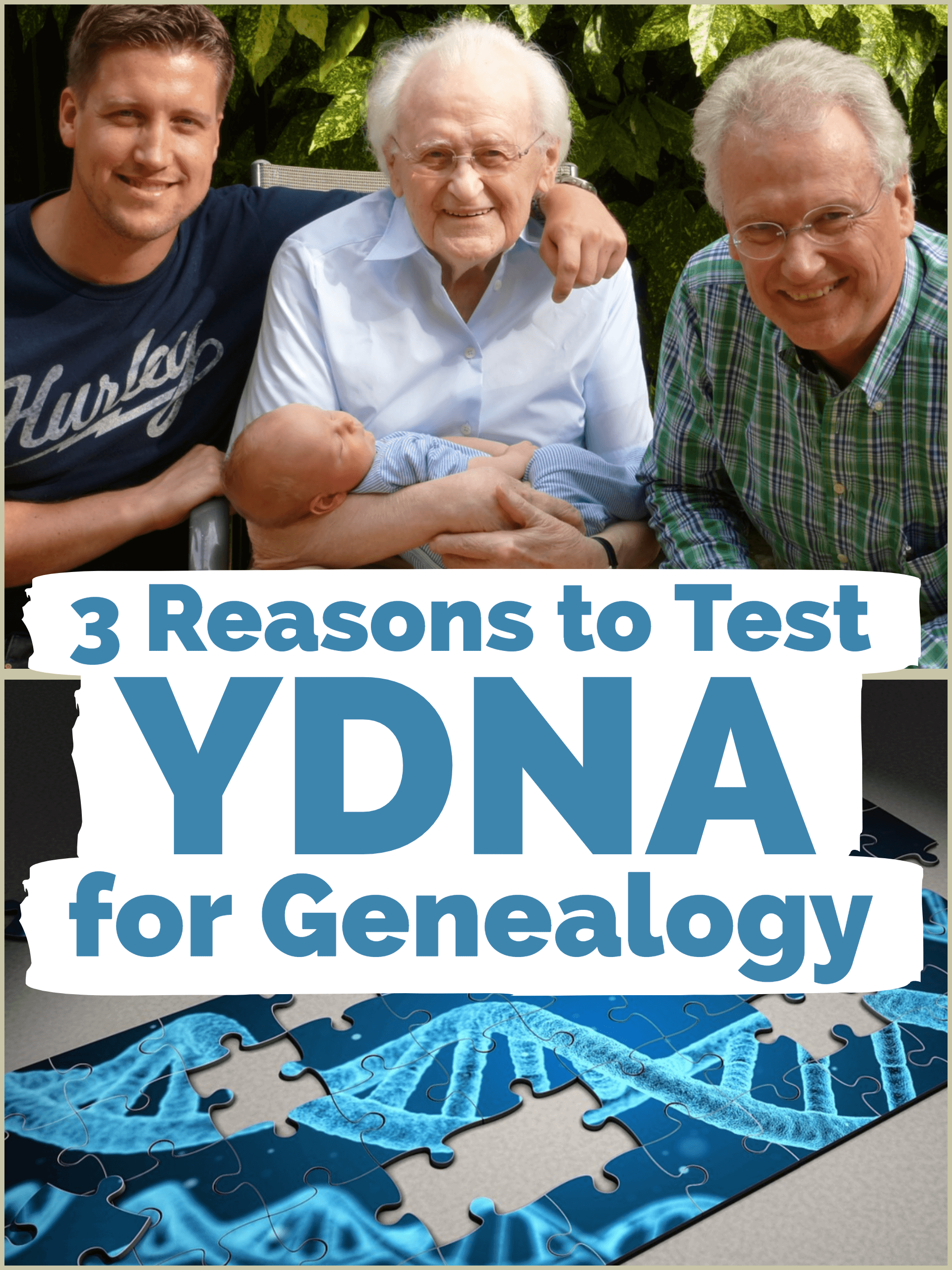by Lisa Cooke | Aug 20, 2016 | 01 What's New, DNA, Societies |

The Daughters of the American Revolution (DAR) accepts limited DNA evidence to prove descent from a Revolutionary War veteran. In my opinion, the DAR DNA policy is a little too limited. Here’s why–and what you can do.
Membership to the Daughters of the American Revolution (DAR) has been a holy grail for U.S. genealogists for 125 years. With its requirement of proof of a “lineal bloodline descendant from an ancestor who aided in achieving American independence” in three categories: birth, marriage, and death, as well as proof of Revolutionary War Service, membership is exclusive to those with an iron-clad paper trail.
That is, until 2014, when the DAR added DNA evidence to its list of acceptable documents proving a relationship to a Revolutionary War ancestor.
What does the DAR DNA Policy Accept?
The DAR only accepts one of the three forms of DNA testing which is the Y chromosome test, or YDNA. The YDNA traces only a direct paternal line, making it a great choice when trying to link living males with their Revolutionary counterparts. This YDNA is basically passed unchanged from generation to generation, making the modern day holder of the YDNA the proud owner of possibly exactly the same YDNA that fought the Redcoats. That’s pretty cool, don’t you think?
The DAR recently announced that to further help those wanting to use their YDNA as part of their application, they have formed a project at Family Tree DNA, the company that provides the YDNA testing. Projects are absolutely the best way to get the most out of your YDNA testing. There are surname projects, location projects, haplogroup (deep ancestral group) projects, and even special interest group projects, such as this one for the DAR.
While the results of the testing are only available to members of the group, the statistics page gives us an idea of the scope of this project. They currently have 1,242 total members and what looks to be about 430 YDNA tests completed (though it is admittedly difficult to tell based on the chart online.) This means if you think your paternal line may be a candidate for the DAR, you can have a representative of your line tested and compared to the group. If you find a match, you will have relative certainty that you do connect to that Patriot, and can then be more confident in your traditional research in pursuit of the necessary paper connections.
In April the DAR opened up project membership to include mtDNA and autosomal DNA. They will not be using these two kinds of DNA in their applications (yet), but hopefully this project will pave the way for the addition of those tests in the future (though, for several reasons, inclusion of these tests in the application process will be more difficult.)
Though, in all honesty, they have made the YDNA process difficult enough. Let’s say that you are actually able to trace down multiple generations to find a direct male descendant of your Revolutionary guy to be tested, an individual who is, the DAR mandates, “sharing your maiden name or your mother’s maiden name,” and you convince that unassuming relative to give up his saliva, you still are only half way there. The DAR guidelines also state that you have to have a second individual who is “a descendant of the same Revolutionary War ancestor through a different unbroken male lineage that has been previously proven on a DAR application…” (I added the emphasis here.)
A Practical Example of the DAR DNA Policy
OK, so let’s say you are a genealogical whiz and, let’s face it, you were lucky, and you find two such candidates and have them tested.
Well, the DAR tells us that those two men must match EXACTLY on the 37 YDNA markers tested. Now there is no telling when that YDNA might experience a mutation. So to me it seems a little unfair to require perfection. So it is possible, that even after all the work of finding the right guys to be tested, the test itself may work against you, as even one difference is enough to keep this YDNA off of your application, at least for now.
So while I applaud the DAR for using YDNA testing at all, and for spearheading a special interest project at Family Tree DNA, the reality is that the limitations of direct paternal line genealogy and the requirements of testing make it unlikely that very many will be able to take advantage of the YDNA in their DAR applications.
However, there are a few things you can take away from this article now:
- First, collect those DNA samples whenever you can, especially for key relatives, like your paternal line and the oldest living generation (whose DNA is less likely to have experienced any mutation.)
- Second, keep your research paper trail strong. Nothing in the near future of the genetic genealogy industry tells us that distant relative connections (like to your Revolutionary War ancestor) will be provable by DNA alone.
- And third, definitely look at crowd-sourced studies for your particular DNA. Those surname, location, haplogroup, and special interest group projects I mentioned from FTDNA are just some of the ones that might help your research—or that you could use to help someone else’s. I’ve talked about these studies before: click here to read about them.
My Complete DNA for Genealogy Research Guide Series
I am Diahan Southard, Your DNA Guide, and the author of a series of genetic genealogy quick guides. My guide called Y Chromosome DNA for the Genealogist is the perfect tool to help guide you through the testing and analysis process. Click here to learn more about this guide and here for all of my guides, or click here to learn more about my series of how-to videos, also available to Gems fans for a special price.
Thanks for sharing this post with your genealogy friends who do DNA research (especially those who may have Revolutionary War ancestors!)
by Diahan Southard | Apr 27, 2016 | 01 What's New, DNA, Research Skills
Have you been wondering what’s up with the Y? After taking an autosomal DNA test, many genealogists want to know what next steps to take, and if YDNA can help further their research. YDNA, which can only be taken by males, may be able to bust additional brick walls in your family. DNA expert Diahan Southard is here to share 3 reasons to take a YDNA test–or have a male relative do so.
The Y chromosome DNA test, more affectionately referred to as the YDNA test, is the darling of the DNA testing industry. (At least, I think so.) In fact, of the three kinds of DNA tests, the YDNA is my favorite. Currently, the YDNA test is available at Family Tree DNA. Here’s their quick recap of what YDNA is:
“Y-DNA is what we call the sex chromosome “Y” that is passed from a father to his sons only, women do not receive a Y chromosome. Testing the Y chromosome allows for investigation into a male’s paternal family line and can help identify surname lines, living relatives whose Y chromosome is similar to yours, and ancient migration routes your paternal ancestors may have taken.”
At Family Tree DNA, there are four levels of YDNA testing available. 37 markers is the base level and a good place to start making connections. You can also increase your marker count to 67, 111, or if you’re a DNA expert, you can opt for the whopping 700 marker test. The good news is that you can start with the 37 marker test and have the option to upgrade to the larger test without needing to provide another sample.
YDNA has several excellent qualities that make it useful in many genealogical scenarios. Let’s look at three to give you a good start!
Use YDNA for Genealogy When…
1. You Have a Missing Father
All of us should be able to identify with this genealogical problem. Every line in your family history has this problem. Any ancestor whose father is currently unknown falls in this category. And YDNA can help.
The specific quality of YDNA that makes it so attractive in this case is its faithfulness in passing down its record generation after generation, without fail, without changing, from one man to the next. That means that any living male today has the same (or very similar) YDNA as every male in his direct paternal line, back 8, 10, 12+ generations.
Therefore every man’s YDNA is the clue that could lead you to discover that missing father. Usually what it takes is a match in the YDNA database with another descendant of your common ancestor. Ideally, this person knows something that you don’t about that missing father, and the two of you can work together to verify and extend your family history.
2. Your Relative is Worried About Privacy
While DNA testing has certainly entered a season of relative acceptance among genealogists, there are still many skeptics who wonder what the eventual ramifications of having your DNA tested might bring. While this is a subject that certainly deserves some attention, the YDNA is actually the easiest test to sell to a nervous relative.
The very qualities that make YDNA testing valuable, namely that every male descendant of a given ancestor will have the same YDNA, make it equally impossible to identify any particular individual uniquely. This means that the YDNA record that is created when a man takes a YDNA test cannot ever be traced back to him alone. That same record could have easily come from his brother, or 1st, or 5th cousin.
Similarly, the YDNA test results do not have a link to your health. The regions that are tested are generally parts that are not useful for determining any kind of personal health or trait information.
3. You Have a Surname Mix-up
One of the best applications of YDNA for genealogy comes when trying to disentangle the relationships of various men living in close proximity with other men of the same or similar surname. Having descendants of these men test their YDNA is like traveling back in time and conducting personal interviews of each of these men. It’s like saying, “Excuse me, Mr. Moffat? Is this neighbor of yours, Mr. Moffit, your uncle?” Wouldn’t you give anything for a chance to have that conversation? Well, YDNA testing gets you almost there. You might not be able to determine if they are uncle and nephew, but you will at least know if they are kin.
So what are you waiting for? If you have your own YDNA, go out and start the testing process. If you have been blessed instead with two X chromosomes, send this article over to your favorite male relative and let him know that he holds a very old, very valuable record in his DNA and you want to help him make use of it.
Learn More About DNA Test Options in This Free Video Class
Learn more about YDNA testing and the other types of DNA tests in this free video class, filmed live at RootsTech 2018! You’ll get answers to questions like:
- Which DNA test should I take?
- What will I get from the DNA test results?
- Will DNA testing help with genealogy?
If you or the relative you want to test wants more information about what DNA testing is all about, this is the perfect recap. And best of all, it includes helpful slides, graphics, and it’s all in plain English!
About the Author: Diahan Southard has worked with the Sorenson Molecular Genealogy Foundation, and has been in the genetic genealogy industry since it has been an industry. She holds a degree in Microbiology and her creative side helps her break the science up into delicious bite-sized pieces for you. She’s the author of a full series of DNA guides for genealogists.
Disclosure: This article contains affiliate links and Genealogy Gems will be compensated if you make a purchase after clicking on these links (at no additional cost to you). Thank you for supporting Genealogy Gems!
This article was originally published on April 27, 2016 and updated on May 2, 2019.
by Lisa Cooke | Mar 10, 2016 | 01 What's New, Genealogy Gems Podcast, Genealogy TV
 The free Genealogy Gems Podcast episode 189 is published, with an exclusive interview with stars of Relative Race and more.
The free Genealogy Gems Podcast episode 189 is published, with an exclusive interview with stars of Relative Race and more.
The newest episode of the Genealogy Gems Podcast is published and ready for your listening pleasure! Two stars of the new BYUtv show Relative Race join host Lisa Louise Cooke to talk about their experiences criss-crossing the U.S. to meet their AncestryDNA matches.
Here are some more highlights from Genealogy Gems Podcast episode 189:
- Irish research tips–and tons of new Irish records online–in honor of St. Patrick’s Day this month;
- 3 reasons to test your DNA for genealogy, from Your DNA Guide Diahan Southard;
- an excerpt from the new Genealogy Gems Book Club interview;
- emails from several listeners offering inspiration and tips;
- and news from the genealogy world, including databases on runaway slaves (in the U.S. and Britain) and an updated MyHeritage search technology.
I’m a fan of “genealogy TV,” and it’s fun to hear behind-the-scenes feedback from stars of Relative Race. This show’s approach–connecting everyday couples with genetic matches–puts faces to our DNA matches in a fresh and personal way. I’m not hoping to camp on my genetic matches’ lawns anytime soon, but I do sometimes wish I could knock on the doors of some (“please respond!”). Another favorite take-away from this episode was a tip from Matt in Missouri, who wrote in with a creative approach for connecting with relatives through Find A Grave.
 Remember, this and all episodes of the Genealogy Gems podcast are FREE to listen to. Click here for FAQ on podcasts and how to listen on your computer or via your favorite mobile device. Click here for a list of past episodes you may have missed. Why not “binge out” a little and catch up during your next commute, workout or down time?
Remember, this and all episodes of the Genealogy Gems podcast are FREE to listen to. Click here for FAQ on podcasts and how to listen on your computer or via your favorite mobile device. Click here for a list of past episodes you may have missed. Why not “binge out” a little and catch up during your next commute, workout or down time?
by Lisa Cooke | Feb 25, 2015 | 01 What's New, Book Club, Conferences, DNA, FamilySearch, Genealogy Gems Podcast, RootsTech
 The newest episode of the FREE Genealogy Gems podcast–episode 176–has published and it is PACKED with gems!
The newest episode of the FREE Genealogy Gems podcast–episode 176–has published and it is PACKED with gems!
Lisa begins with her own in-depth comments on RootsTech 2015. Whether you attended or didn’t, I think you’ll find her front-row analysis of the world’s biggest family history event pretty interesting! I appreciate her insight that RootsTech isn’t just about teaching people to do family history. It’s about motivating and inspiring their legacy-building efforts. I have sometimes felt a lack of that at conferences myself: I get a lot of how-to but not the energizing “why-to” that I sometimes need myself.
I join Lisa to talk about the Genealogy Book Club and MORE great reads for family history lovers. We’re still reading Orphan Train by Christina Baker Kline, which offers up a history lesson about the thousands of neglected children who were shipped off by train to rural homes in the U.S. and Canada. In the context of an unlikely friendship between an elderly orphan train rider and a modern teenage girl in the foster care system, we learn how much of a child’s identity comes wrapped up in their family’s backstory. Lisa and I also talk about writing family history using different voices. I recommend books written in a few different voices, or styles.
Another great segment in this episode is the topic of yDNA research and surname studies. Genetics is re-invigorating those “one-name” groups that explore their common surname heritage. As in every episode of the Genealogy Gems podcast, you’ll get some great tips and learn about online resources you may not have seen. You’ll hear from our listeners and readers with questions and comments. And we hope you’ll respond with your own! Click here to listen to the podcast and read the show notes.

by Lisa Cooke | Feb 25, 2015 | 01 What's New, DNA, images, Listeners & Readers

Recently, Norma wrote in with this question about getting DNA from a hair sample:
“My sister-in-law’s father passed away before she could have his DNA tested. She does have samples of his hair. She was wondering if there is a lab who would do DNA testing for genealogy using hair samples? FamilyTree DNA and 23 and Me both do not do testing on hair. There are no other male relatives that she is aware that could be tested. She is interested in the yDNA especially.”

I turned to Your DNA Guide at Genealogy Gems, Diahan Southard, and here’s her answer:
“Good question! This is a common concern for many. Unfortunately, cut hair (which I am assuming is what you have) does not contain the necessary material for DNA testing. If he had any teeth pulled that she had saved, that would be a good source. Even sometimes a razor will work.
But even if you could find a suitable sample, as you mentioned, the standard genealogical testing companies do not accept non-standard samples. There is a company who does, called Identigene, but the testing is expensive, and really won’t give you what need, which is access to a yDNA database to look for matches.
Your best route is to continue to look for a direct paternal descendant of the line of interest. If your friend’s dad didn’t have any brothers, then what about her grandfather? Are there any first cousins around? What you are looking for is a living male who has the surname you are interested in.

If you can’t find one, your friend can still explore the autosomal DNA test, which will tell her about her paternal side, just in a less direct manner.





 Remember, this and all episodes of the Genealogy Gems podcast are FREE to listen to.
Remember, this and all episodes of the Genealogy Gems podcast are FREE to listen to. 







